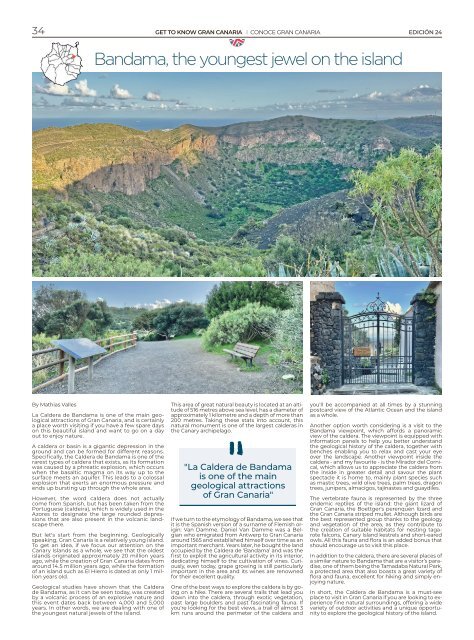No. 24 - Its Gran Canaria Magazine
Rutas, recomendaciones y noticias de Gran Canaria. Routes, tips and news about Gran Canaria.
Rutas, recomendaciones y noticias de Gran Canaria.
Routes, tips and news about Gran Canaria.
Create successful ePaper yourself
Turn your PDF publications into a flip-book with our unique Google optimized e-Paper software.
34<br />
GET TO KNOW GRAN CANARIA I CONOCE GRAN CANARIA EDICIÓN <strong>24</strong><br />
Bandama, the youngest jewel on the island<br />
By Mathias Valles<br />
La Caldera de Bandama is one of the main geological<br />
attractions of <strong>Gran</strong> <strong>Canaria</strong>, and is certainly<br />
a place worth visiting if you have a few spare days<br />
on this beautiful island and want to go on a day<br />
out to enjoy nature.<br />
A caldera or basin is a gigantic depression in the<br />
ground and can be formed for different reasons.<br />
Specifically, the Caldera de Bandama is one of the<br />
rarest types of caldera that exists, as its formation<br />
was caused by a phreatic explosion, which occurs<br />
when the basaltic magma on its way up to the<br />
surface meets an aquifer. This leads to a colossal<br />
explosion that exerts an enormous pressure and<br />
ends up bursting up through the whole area.<br />
However, the word caldera does not actually<br />
come from Spanish, but has been taken from the<br />
Portuguese (caldeira), which is widely used in the<br />
Azores to designate the large rounded depressions<br />
that are also present in the volcanic landscape<br />
there.<br />
But let's start from the beginning. Geologically<br />
speaking, <strong>Gran</strong> <strong>Canaria</strong> is a relatively young island.<br />
To get an idea, if we focus our attention on the<br />
Canary Islands as a whole, we see that the oldest<br />
islands originated approximately 20 million years<br />
ago, while the creation of <strong>Gran</strong> <strong>Canaria</strong> dates from<br />
around 14.5 million years ago, while the formation<br />
of an island such as El Hierro is dated at only 1 million<br />
years old.<br />
Geological studies have shown that the Caldera<br />
de Bandama, as it can be seen today, was created<br />
by a volcanic process of an explosive nature and<br />
this event dates back between 4,000 and 5,000<br />
years. In other words, we are dealing with one of<br />
the youngest natural jewels of the island.<br />
This area of great natural beauty is located at an altitude<br />
of 516 metres above sea level, has a diameter of<br />
approximately 1 kilometre and a depth of more than<br />
200 metres. Taking these stats into account, this<br />
natural monument is one of the largest calderas in<br />
the Canary archipelago.<br />
"<br />
"La Caldera de Bandama<br />
is one of the main<br />
geological attractions<br />
of <strong>Gran</strong> <strong>Canaria</strong>"<br />
If we turn to the etymology of Bandama, we see that<br />
it is the Spanish version of a surname of Flemish origin:<br />
Van Damme. Daniel Van Damme was a Belgian<br />
who emigrated from Antwerp to <strong>Gran</strong> <strong>Canaria</strong><br />
around 1565 and established himself over time as an<br />
important merchant. Years later, he bought the land<br />
occupied by the Caldera de ‘Bandama’ and was the<br />
first to exploit the agricultural activity in its interior,<br />
dedicating himself to the cultivation of vines. Curiously,<br />
even today, grape growing is still particularly<br />
important in the area and its wines are renowned<br />
for their excellent quality.<br />
One of the best ways to explore the caldera is by going<br />
on a hike. There are several trails that lead you<br />
down into the caldera, through exotic vegetation,<br />
past large boulders and past fascinating fauna. If<br />
you're looking for the best views, a trail of almost 3<br />
km runs around the perimeter of the caldera and<br />
you'll be accompanied at all times by a stunning<br />
postcard view of the Atlantic Ocean and the island<br />
as a whole.<br />
Another option worth considering is a visit to the<br />
Bandama viewpoint, which affords a panoramic<br />
view of the caldera. The viewpoint is equipped with<br />
information panels to help you better understand<br />
the geological history of the caldera, together with<br />
benches enabling you to relax and cast your eye<br />
over the landscape. Another viewpoint inside the<br />
caldera - and my favourite - is the Mirador del Cornical,<br />
which allows us to appreciate the caldera from<br />
the inside in greater detail and savour the plant<br />
spectacle it is home to, mainly plant species such<br />
as mastic trees, wild olive trees, palm trees, dragon<br />
trees, junipers, almacigos, tajinastes and guaydiles.<br />
The vertebrate fauna is represented by the three<br />
endemic reptiles of the island: the giant lizard of<br />
<strong>Gran</strong> <strong>Canaria</strong>, the Boettger's perenquén lizard and<br />
the <strong>Gran</strong> <strong>Canaria</strong> striped mullet. Although birds are<br />
the best represented group thanks to the geology<br />
and vegetation of the area, as they contribute to<br />
the creation of suitable habitats for nesting tagarote<br />
falcons, Canary Island kestrels and short-eared<br />
owls. All this fauna and flora is an added bonus that<br />
should encourage us to visit this place.<br />
In addition to the caldera, there are several places of<br />
a similar nature to Bandama that are a visitor’s paradise,<br />
one of them being the Tamadaba Natural Park,<br />
a protected area that also boasts a great variety of<br />
flora and fauna, excellent for hiking and simply enjoying<br />
nature.<br />
In short, the Caldera de Bandama is a must-see<br />
place to visit in <strong>Gran</strong> <strong>Canaria</strong> if you are looking to experience<br />
fine natural surroundings, offering a wide<br />
variety of outdoor activities and a unique opportunity<br />
to explore the geological history of the island.
















